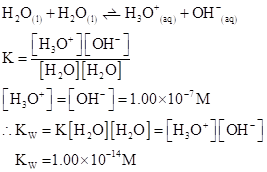
(a)
Interpretation:
The  of water at given temperatures should be determined.
of water at given temperatures should be determined.
Concept Introduction:
 : The concentration of hydrogen ion is measured using
: The concentration of hydrogen ion is measured using  scale. The
scale. The  of a solution is a figure that expresses the acidity or the alkalinity of a given solution.
of a solution is a figure that expresses the acidity or the alkalinity of a given solution.
It is defined as the negative base-10 logarithm of the hydrogen or hydronium ion concentration.

If the value of  is less than
is less than , then the solution is acidic whereas if the value of
, then the solution is acidic whereas if the value of  is greater than
is greater than , then the solution is basic.
, then the solution is basic.
(b)
Interpretation:
The  at given temperature should be determined.
at given temperature should be determined.
Concept Introduction:
Ionic-product constant for water: It is the hydronium ion concentration times the  concentration present in the solution.
concentration present in the solution.

The  will apply to all aqueous solution.
will apply to all aqueous solution.
For acidic solution  is large that is
is large that is 
For basic solution  is large that is
is large that is 
(c)
Interpretation:
The dissociation of water should be identified that whether it is an exothermic or endothermic reaction.
Concept Introduction:
Endothermic reaction: The reaction is considered as endothermic when heat energy is absorbed from surroundings during reaction.
Exothermic reaction: The reaction is considered as endothermic when heat energy is released to the surroundings during reaction.
Want to see the full answer?
Check out a sample textbook solution
Chapter 10 Solutions
Fundamentals of General, Organic, and Biological Chemistry (8th Edition)
- If there is an increase in the hydrogen ion concentration from 38 nmol.l-1 to 82 nmol.l-1, what does the pH change from and to?arrow_forwardMany proteins that remain homogeneously distributed in water have molecular masses in the range of 30,000 amu and larger. In what sense is it appropriate to consider such suspensions to be colloids rather than solutions? Explain.arrow_forwardHow many grams of NaOH are needed to make 50 mL of a 0.02 g/mL NaOH solution? How many grams of HCl are needed to make 10 uL of a 0.005g/mL acid solution? How many grams of CuSO4 would you use to make 1 L of an 8 g/L CuSO4 solution? 12 grams of glucose will make how many mL of a 0.5 g/mL solution? If you mix 9 g of NaOH with 90 mL of water, what is the mass/volume (g/mL) concentration of the solution?arrow_forward
- Ethylene glycol, the main ingredient in antifreeze, contains 38.7% carbon, 9.7% hydrogen and 51.6 % oxygen. Calculate the empirical and molecular formulas for ethylene glycol. Given the molar mass is approximately 60 g/mol. A) Empirical formula: B)Molecular formula: Explain how you obtained the Molecular formula (b)?arrow_forwardFor an acid HA, the concentrations of HA and A are 0.075 and 0.025, respectively, at pH 6.0. What is the p K a value for HA?arrow_forwardA solution with a density of 0.876 g>mL contains 5.0 g of toluene 1C7H82 and 225 g of benzene. Calculate the molarity of the solution.arrow_forward
- Beyond the differences in molecular mass, what is different about determining the molarity of a solution containing a salt (e.g. NaCl, MgCl2) versus a covalently linked molecule (e.g. glucose)?arrow_forwardA sample of KNO3 ( 225 g) is completely dissolved in water (250 g) at 333.15 K. The solution is gradually colled to 273.15 K. At this coller temperature, KNO3 solubility in H2O is 12.1 g/100 g H2O. What mass of KNO3 (in g) will crystallize out of the solution at 273.15 K?arrow_forwardIf 0.752 moles of (NH3OH)Cl is dissolved in 1 L of water what is the pH of the solution?arrow_forward
- Assuming equal concentrations of conjugate base and acid, which one of the following mixtures is suitable for making a buffer solution with an optimum pH of 7.4–7.6? NaOCl / HOCl (K a = 3.2 × 10 –8) NH 3 / NH 4Cl (K a = 5.6 × 10 –10) NaNO 2 / HNO 2 (K a = 4.5 × 10 –4) NaCl / HCl CH 3COONa / CH 3COOH (K a = 1.8 × 10 –5)arrow_forwardA compound with empirical formula C2H5O was found in a separate experiment to have a molar mass of approximately 90 g. What is the molecular formula of the compound?arrow_forwardFor a weak acid with a pKa of 6.0, calculate the ratio of conjugate base to acid at a pH of 5.0arrow_forward
 BiochemistryBiochemistryISBN:9781319114671Author:Lubert Stryer, Jeremy M. Berg, John L. Tymoczko, Gregory J. Gatto Jr.Publisher:W. H. Freeman
BiochemistryBiochemistryISBN:9781319114671Author:Lubert Stryer, Jeremy M. Berg, John L. Tymoczko, Gregory J. Gatto Jr.Publisher:W. H. Freeman Lehninger Principles of BiochemistryBiochemistryISBN:9781464126116Author:David L. Nelson, Michael M. CoxPublisher:W. H. Freeman
Lehninger Principles of BiochemistryBiochemistryISBN:9781464126116Author:David L. Nelson, Michael M. CoxPublisher:W. H. Freeman Fundamentals of Biochemistry: Life at the Molecul...BiochemistryISBN:9781118918401Author:Donald Voet, Judith G. Voet, Charlotte W. PrattPublisher:WILEY
Fundamentals of Biochemistry: Life at the Molecul...BiochemistryISBN:9781118918401Author:Donald Voet, Judith G. Voet, Charlotte W. PrattPublisher:WILEY BiochemistryBiochemistryISBN:9781305961135Author:Mary K. Campbell, Shawn O. Farrell, Owen M. McDougalPublisher:Cengage Learning
BiochemistryBiochemistryISBN:9781305961135Author:Mary K. Campbell, Shawn O. Farrell, Owen M. McDougalPublisher:Cengage Learning BiochemistryBiochemistryISBN:9781305577206Author:Reginald H. Garrett, Charles M. GrishamPublisher:Cengage Learning
BiochemistryBiochemistryISBN:9781305577206Author:Reginald H. Garrett, Charles M. GrishamPublisher:Cengage Learning Fundamentals of General, Organic, and Biological ...BiochemistryISBN:9780134015187Author:John E. McMurry, David S. Ballantine, Carl A. Hoeger, Virginia E. PetersonPublisher:PEARSON
Fundamentals of General, Organic, and Biological ...BiochemistryISBN:9780134015187Author:John E. McMurry, David S. Ballantine, Carl A. Hoeger, Virginia E. PetersonPublisher:PEARSON





